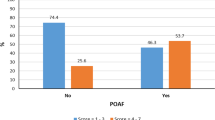Abstract
Purpose
To validate the predictive value of the aortic knob index for identifying new-onset postoperative atrial fibrillation (POAF) after off-pump coronary artery bypass grafting (OPCAB).
Methods
Among 156 patients who underwent isolated OPCAB, 138 consecutive patients without a history of atrial fibrillation were enrolled in this retrospective observational cohort study. The patients were divided into two groups based on the development of POAF. We compared the baseline clinical characteristics; preoperative radiographic characteristics of the aorta, including aortic knob measurements; and perioperative data, between the groups. Logistic regression analysis was performed to identify the predictors of new-onset POAF.
Results
New-onset POAF developed in 35 (25.4%) patients. Multivariate logistic regression analysis revealed that the aortic knob index was an independent predictor of POAF and yielded that the risk of POAF increased by 1.85 times when the aortic knob index increased by 0.1 (odds ratio, 1.853; confidence interval, 1.326–2.588; P < 0.001). Receiver operating characteristic analysis revealed that an aortic knob index of 1.364 constituted a cutoff value for new-onset POAF with 80.0% sensitivity and 65.0% specificity.
Conclusions
The aortic knob index on preoperative chest radiography was a significant and independent predictor of new-onset POAF following OPCAB.




Similar content being viewed by others
Data availability
The data underlying this article are available from the corresponding author upon reasonable request.
References
Phan K, Ha HS, Phan S, Medi C, Thomas SP, Yan TD. New-onset atrial fibrillation following coronary bypass surgery predicts long-term mortality: a systematic review and meta-analysis. Eur J Cardiothorac Surg. 2015;48:817–24.
Filardo G, Damiano RJ Jr, Ailawadi G, Thourani VH, Pollock BD, Sass DM, et al. Epidemiology of new-onset atrial fibrillation following coronary artery bypass graft surgery. Heart. 2018;104:985–92.
Schnaubelt S, Pilz A, Koller L, Kazem N, Hofer F, Fleck T, et al. The impact of volume substitution on post-operative atrial fibrillation. Eur J Clin Invest. 2021;51: e13456.
Ishii Y, Schuessler RB, Gaynor SL, Hames K, Damiano RJ Jr. Postoperative atrial fibrillation: the role of the inflammatory response. J Thorac Cardiovasc Surg. 2017;153:1357–65.
Karabacak K, Kubat E, Akyol FB, Kadan M, Erol G, Doğancı S, et al. The C-reactive protein/albumin ratio as a new predictor for postoperative atrial fibrillation after coronary artery bypass graft surgery. J Card Surg. 2020;35:2747–53.
Ishida K, Kimura F, Imamaki M, Ishida A, Shimura H, Kohno H, et al. Relation of inflammatory cytokines to atrial fibrillation after off-pump coronary artery bypass grafting. Eur J Cardiothorac Surg. 2006;29:501–5.
Yamazoe M, Sasano T, Ihara K, Takahashi K, Nakamura W, Takahashi N, et al. Sparsely methylated mitochondrial cell free DNA released from cardiomyocytes contributes to systemic inflammatory response accompanied by atrial fibrillation. Sci Rep. 2021;11:5837.
Tomita Y, Kasai T, Ishiwata S, Daida H, Narui K. Aortic knob width as a novel indicator of atherosclerosis and obstructive sleep apnea. J Atheroscler Thromb. 2020;27:501–8.
Lee EJ, Han JH, Kwon KY, Kim JH, Han KH, Sung SY, et al. The relationship between aortic knob width and metabolic syndrome. Korean J Fam Med. 2018;39:253–9.
Erdem K, Oztürk S, Ayhan S, Buğra O, Bozoğlan O, Tekelioğlu ÜY, et al. Predictive value of aortic knob width for postoperative atrial fibrillation in coronary artery bypass surgery. Anadolu Kardiyol Derg. 2014;14:68–72.
Shankar N, Veeramani R, Ravindranath R, Philip B. Anatomical variations of the aortic knob in chest radiographs. Eur J Anat. 2010;14:25–30.
Lang RM, Badano LP, Mor-Avi V, Afilalo J, Armstrong A, Ernande L, et al. Recommendations for cardiac chamber quantification by echocardiography in adults: an update from the American society of echocardiography and the European association of cardiovascular imaging. Eur Heart J Cardiovasc Imaging. 2015;16:233–70.
Hashimoto H, Iijima K, Hashimoto M, Son BK, Ota H, Ogawa S, et al. Validity and usefulness of aortic arch calcification in chest X-ray. J Atheroscler Thromb. 2009;16:256–64.
Rantasalo V, Gunn J, Kiviniemi T, Hirvonen J, Saarenpää I, Kivelev J, et al. Intracranial aneurysm is predicted by abdominal aortic calcification index: a retrospective case-control study. Atherosclerosis. 2021;334:30–8.
Omer S, Cornwell LD, Bakshi A, Rachlin E, Preventza O, Rosengart TK, et al. Incidence, predictors, and impact of postoperative atrial fibrillation after coronary artery bypass grafting in military veterans. Tex Heart Inst J. 2016;43:397–403.
LaPar DJ, Speir AM, Crosby IK, Fonner E Jr, Brown M, Rich JB, et al. Postoperative atrial fibrillation significantly increases mortality, hospital readmission, and hospital costs. Ann Thorac Surg. 2014;98:527–33.
Eikelboom R, Sanjanwala R, Le ML, Yamashita MH, Arora RC. Postoperative atrial fibrillation after cardiac surgery: a systematic review and meta-analysis. Ann Thorac Surg. 2021;111:544–54.
Nso N, Bookani KR, Metzl M, Radparvar F. Role of inflammation in atrial fibrillation: a comprehensive review of current knowledge. J Arrhythm. 2020;37:1–10.
Korantzopoulos P, Letsas KP, Tse G, Fragakis N, Goudis CA, Liu T. Inflammation and atrial fibrillation: a comprehensive review. J Arrhythm. 2018;34:394–401.
Agmon Y, Khandheria BK, Meissner I, Schwartz GL, Sicks JD, Fought AJ, et al. Is aortic dilatation an atherosclerosis-related process? Clinical, laboratory, and transesophageal echocardiographic correlates of thoracic aortic dimensions in the population with implications for thoracic aortic aneurysm formation. J Am Coll Cardiol. 2003;42:1076–83.
Redheuil A, Yu WC, Mousseaux E, Harouni AA, Kachenoura N, Wu CO, et al. Age-related changes in aortic arch geometry: relationship with proximal aortic function and left ventricular mass and remodeling. J Am Coll Cardiol. 2011;58:1262–70.
Funakoshi H, Mizobe M, Homma Y, Nakashima Y, Takahashi J, Shiga T. The diagnostic accuracy of the mediastinal width on supine anteroposterior chest radiographs with nontraumatic Stanford type A acute aortic dissection. J Gen Fam Med. 2018;19:45–9.
Knol WG, Bogers AJJC, Braun LMM, van Rosmalen J, Bekker MWA, Krestin GP, et al. Aortic calcifications on routine preoperative chest X-ray and perioperative stroke during cardiac surgery: a nested matched case-control study. Interact Cardiovasc Thorac Surg. 2020;30:507–14.
Funding
No specific funding was received.
Author information
Authors and Affiliations
Contributions
NY conceived of the present idea and wrote the manuscript. NY and KO designed, conducted the study and contributed to data collection. All the authors discussed the results and approved the final manuscript.
Corresponding author
Ethics declarations
Conflict of interest
We have no conflicts of interest to declare in association with the present study.
Additional information
Publisher's Note
Springer Nature remains neutral with regard to jurisdictional claims in published maps and institutional affiliations.
Rights and permissions
Springer Nature or its licensor (e.g. a society or other partner) holds exclusive rights to this article under a publishing agreement with the author(s) or other rightsholder(s); author self-archiving of the accepted manuscript version of this article is solely governed by the terms of such publishing agreement and applicable law.
About this article
Cite this article
Yamamoto, N., Onoda, K. The aortic knob index as a novel predictor of new-onset atrial fibrillation after off-pump coronary artery bypass grafting. Surg Today 54, 168–176 (2024). https://doi.org/10.1007/s00595-023-02717-6
Received:
Accepted:
Published:
Issue Date:
DOI: https://doi.org/10.1007/s00595-023-02717-6




